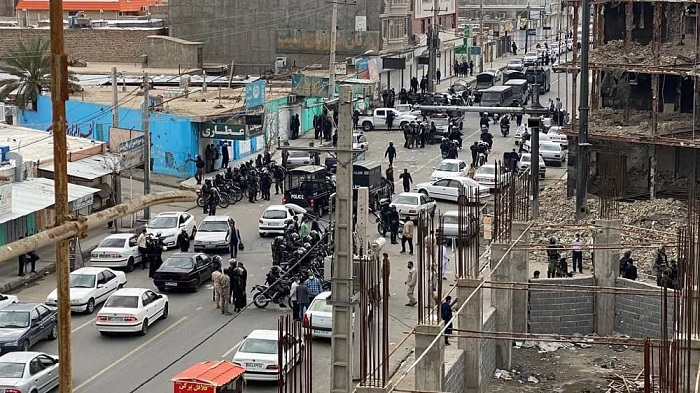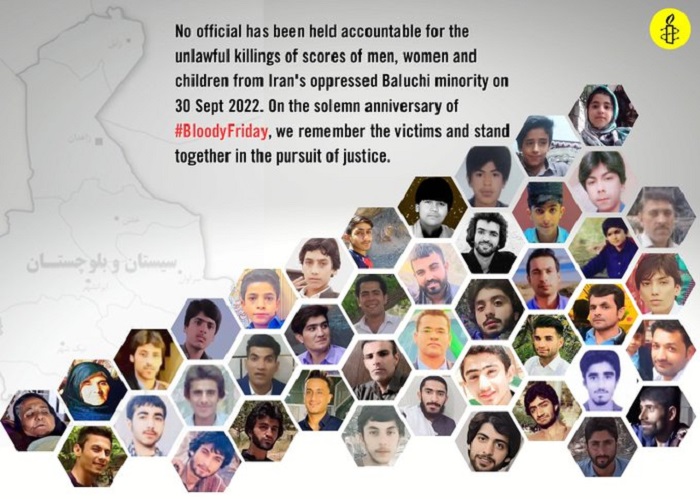

This atrocity draws a chilling parallel to the “Black Friday” of September 8, 1978, where a monarchic dictator attempted to crush an uprising.
Supreme Leader Ali Khamenei, believing he could stifle the nationwide revolt by targeting its most vulnerable sections, ordered a brutal onslaught on Baluch citizens, demanding justice and equality. Security forces, aided by snipers on rooftops and paramilitary units, responded with violence, leading to the death of 120 individuals, including four women and 17 children. Another 300 were injured.
Instead of expressing remorse or empathy, Khamenei sent a delegation 40 days after the massacre to suppress the rising voices of discontent. This representative lauded those responsible for the massacre, fueling their convictions.

Adding to the deep wounds, security forces orchestrated another bloodbath in Khash on November 4, 2022, killing 18 individuals, inclusive of two children. These massacres were meant to intimidate and suppress the Baluch citizens. However, they only invigorated the uprising, with “Bloody Friday in Zahedan” evolving into a weekly tradition of protests and defiance.
Iranians nationwide, remembering the fortieth day of the massacre on November 9, 2022, expressed solidarity with Baluchestan. Anti-regime protests surged in multiple cities, and students from premier universities voiced their protests. This nationwide unity countered the regime’s propaganda, which maliciously painted the Baluchistan and Kurdistan uprisings as “separatist” movements.
Last year, on Friday, September 30, 2022, #Zahedan was drenched in blood, sparking outrage nationwide. Nevertheless, the regime's brutal crackdown only strengthened the resolve of the Iranian people to rise up and bring an end to the oppressive regime, which is already on the… pic.twitter.com/zDuQ1g9B9L
— Maryam Rajavi (@Maryam_Rajavi) September 28, 2023
The Baluchi response, “From Zahedan to Tehran, I sacrifice my life for Iran,” highlighted the profound connection and shared sentiment of the Iranian populace.Internationally, Iranian diaspora echoed these slogans, bringing global attention to the tragic event.
The aftermath of Bloody Friday remains starkly evident in Baluchestan. Children, victims of systemic deprivation, are still searching for answers, wondering why their relatives were slaughtered post-prayer. Many households lost their primary earners, and numerous survivors now lead a life of disability.
The martyrs have become poignant icons of repression and resistance, representing the spirit of revolutionary fervor. The tales of 7-year-old “Hasti Narui,” tragically martyred by a tear gas shell, and “Khodanur Lejai,” symbolizing the indomitable spirit of the Iranian people, are especially emblematic.
Today, courageous protesters in Zahedan and other cities took to the streets despite suppressive measures. They chanted slogans for freedom. Slogans included Death to Khamenei,” “Basiji, IRGC, you are our ISIS,” and “Death to the Basiji.” #جمعه_خونین_زاهدان #Iran #Balochs pic.twitter.com/UcD0swJjwI
— Facts on Iran (@FactsOnIran) September 29, 2023
Despite the heartache and scars, Zahedan’s Fridays now epitomize a series of uprisings and an undying thirst for freedom. The quest for justice will ensure that the protest flame remains alive, as Baluchestan continues its march forward, undeterred.

MEK Iran (follow us on Twitter and Facebook), Maryam Rajavi’s on her site, Twitter & Facebook, NCRI (Twitter & Facebook), and People’s Mojahedin Organization of Iran – MEK IRAN – YouTu







